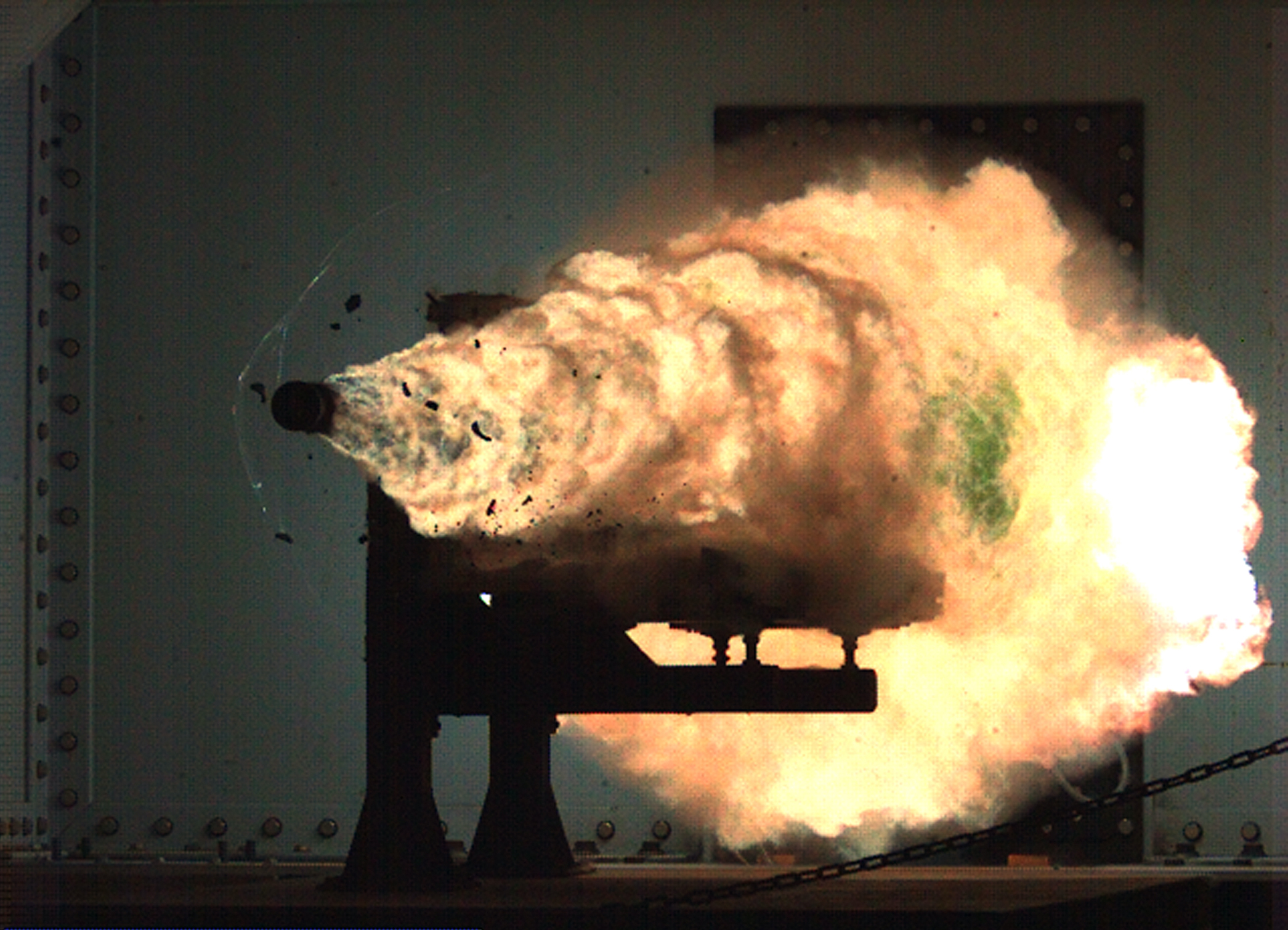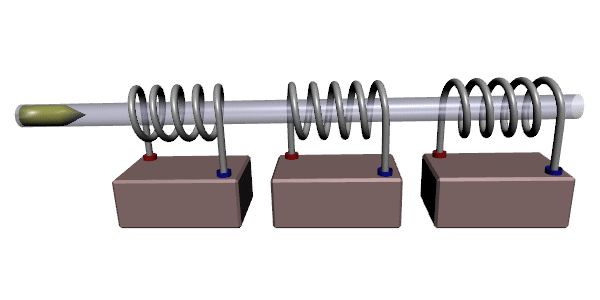|
Magnetic Weapon
A magnetic weapon is one that uses magnetic fields to accelerate or stop projectiles, or to focus charged particle beams. There are many hypothesised magnetic weapons, such as the railgun and coilgun which accelerate a magnetic (in the case of railguns; non-magnetic) mass to a high velocity, or ion cannons and plasma cannons which focus and direct charged particles using magnetic fields. Railguns use two parallel metal rails connected to a power supply. When a conductive projectile is placed between the rails, the circuit is completed and a magnetic field is created down the rails up to the point of the projectile. This creates a force which pushes the projectile along the track, accelerating it to great speeds until it leaves the rails and the circuit is broken. Coilguns, on the other hand, have a barrel made up of coils of magnetic material. The projectile is placed between the coils, which have a pulse of electricity passed through them. This pulls the projectile into the centr ... [...More Info...] [...Related Items...] OR: [Wikipedia] [Google] [Baidu] |
Railgun
A railgun or rail gun is a linear motor device, typically designed as a weapon, that uses Electromagnet, electromagnetic force to launch high velocity projectiles. The projectile normally does not contain explosives, instead relying on the projectile's high speed, mass, and kinetic energy to inflict damage. The railgun uses a pair of parallel conductors (rails), along which a sliding Armature (electrical engineering), armature is accelerated by the electromagnetic effects of a current that flows down one rail, into the armature and then back along the other rail. It is based on principles similar to those of the homopolar motor. As of 2020, railguns have been researched as weapons utilizing electromagnetic forces to impart a very high kinetic energy to a projectile (e.g. APFSDS) rather than using conventional propellants. While explosive-powered military guns cannot readily achieve a muzzle velocity of more than ≈, railguns can readily exceed . For a similar projectile, the ra ... [...More Info...] [...Related Items...] OR: [Wikipedia] [Google] [Baidu] |
Coilgun
A coilgun, also known as a Gauss rifle, is a type of mass driver consisting of one or more coils used as electromagnets in the configuration of a linear motor that accelerate a ferromagnetic or conducting projectile to high velocity. In almost all coilgun configurations, the coils and the gun barrel are arranged on a common axis. A coilgun is not a rifle as the barrel is smoothbore (not rifled). The name "Gauss" is in reference to Carl Friedrich Gauss, who formulated mathematical descriptions of the magnetic effect used by magnetic accelerator cannons. Coilguns generally consist of one or more coils arranged along a barrel, so the path of the accelerating projectile lies along the central axis of the coils. The coils are switched on and off in a precisely timed sequence, causing the projectile to be accelerated quickly along the barrel via magnetic forces. Coilguns are distinct from railguns, as the direction of acceleration in a railgun is at right angles to the central axi ... [...More Info...] [...Related Items...] OR: [Wikipedia] [Google] [Baidu] |
Magnetic
Magnetism is the class of physical attributes that are mediated by a magnetic field, which refers to the capacity to induce attractive and repulsive phenomena in other entities. Electric currents and the magnetic moments of elementary particles give rise to a magnetic field, which acts on other currents and magnetic moments. Magnetism is one aspect of the combined phenomena of electromagnetism. The most familiar effects occur in ferromagnetic materials, which are strongly attracted by magnetic fields and can be magnetized to become permanent magnets, producing magnetic fields themselves. Demagnetizing a magnet is also possible. Only a few substances are ferromagnetic; the most common ones are iron, cobalt, and nickel and their alloys. The rare-earth metals neodymium and samarium are less common examples. The prefix ' refers to iron because permanent magnetism was first observed in lodestone, a form of natural iron ore called magnetite, Fe3O4. All substances exhibit some type ... [...More Info...] [...Related Items...] OR: [Wikipedia] [Google] [Baidu] |
Ion Cannon
A particle-beam weapon uses a high-energy beam of atomic or subatomic particles to damage the target by disrupting its atomic and/or molecular structure. A particle-beam weapon is a type of directed-energy weapon, which directs energy in a particular and focused direction using particles with minuscule mass. Some particle-beam weapons have potential practical applications, e.g. as an antiballistic missile defense system. They have been known by myriad names: particle accelerator guns, ion cannons, proton beams, lightning rays, rayguns, etc. The concept of particle-beam weapons comes from sound scientific principles and experiments. One process is to simply overheat a target until it is no longer operational. However, after decades of research and development, particle-beam weapons remain at the research stage and it remains to be seen if or when they will be deployed as practical, high-performance military weapons. Particle accelerators are a well-developed technology used ... [...More Info...] [...Related Items...] OR: [Wikipedia] [Google] [Baidu] |
Plasma Cannon (other)
Plasma cannon may refer to: *Plasma weapon, a type of raygun that fires a stream, bolt, pulse or toroid of plasma *Plasma railgun, a linear accelerator which, like a projectile railgun, uses two long parallel electrodes to accelerate a "sliding short" armature **MARAUDER, a United States Air Force Research Laboratory project concerning the development of a coaxial plasma railgun *Plasma-powered cannon, an experimental weapon which uses plasma to fire a solid projectile See also *Plasma (other) *Plasma gun (other) {{disambig ... [...More Info...] [...Related Items...] OR: [Wikipedia] [Google] [Baidu] |
Railgun
A railgun or rail gun is a linear motor device, typically designed as a weapon, that uses Electromagnet, electromagnetic force to launch high velocity projectiles. The projectile normally does not contain explosives, instead relying on the projectile's high speed, mass, and kinetic energy to inflict damage. The railgun uses a pair of parallel conductors (rails), along which a sliding Armature (electrical engineering), armature is accelerated by the electromagnetic effects of a current that flows down one rail, into the armature and then back along the other rail. It is based on principles similar to those of the homopolar motor. As of 2020, railguns have been researched as weapons utilizing electromagnetic forces to impart a very high kinetic energy to a projectile (e.g. APFSDS) rather than using conventional propellants. While explosive-powered military guns cannot readily achieve a muzzle velocity of more than ≈, railguns can readily exceed . For a similar projectile, the ra ... [...More Info...] [...Related Items...] OR: [Wikipedia] [Google] [Baidu] |
Coilgun
A coilgun, also known as a Gauss rifle, is a type of mass driver consisting of one or more coils used as electromagnets in the configuration of a linear motor that accelerate a ferromagnetic or conducting projectile to high velocity. In almost all coilgun configurations, the coils and the gun barrel are arranged on a common axis. A coilgun is not a rifle as the barrel is smoothbore (not rifled). The name "Gauss" is in reference to Carl Friedrich Gauss, who formulated mathematical descriptions of the magnetic effect used by magnetic accelerator cannons. Coilguns generally consist of one or more coils arranged along a barrel, so the path of the accelerating projectile lies along the central axis of the coils. The coils are switched on and off in a precisely timed sequence, causing the projectile to be accelerated quickly along the barrel via magnetic forces. Coilguns are distinct from railguns, as the direction of acceleration in a railgun is at right angles to the central axi ... [...More Info...] [...Related Items...] OR: [Wikipedia] [Google] [Baidu] |
Ion Cannon
A particle-beam weapon uses a high-energy beam of atomic or subatomic particles to damage the target by disrupting its atomic and/or molecular structure. A particle-beam weapon is a type of directed-energy weapon, which directs energy in a particular and focused direction using particles with minuscule mass. Some particle-beam weapons have potential practical applications, e.g. as an antiballistic missile defense system. They have been known by myriad names: particle accelerator guns, ion cannons, proton beams, lightning rays, rayguns, etc. The concept of particle-beam weapons comes from sound scientific principles and experiments. One process is to simply overheat a target until it is no longer operational. However, after decades of research and development, particle-beam weapons remain at the research stage and it remains to be seen if or when they will be deployed as practical, high-performance military weapons. Particle accelerators are a well-developed technology used ... [...More Info...] [...Related Items...] OR: [Wikipedia] [Google] [Baidu] |
Directed-energy Weapon
A directed-energy weapon (DEW) is a ranged weapon that damages its target with highly focused energy without a solid projectile, including lasers, microwaves, particle beams, and sound beams. Potential applications of this technology include weapons that target anti-personnel weapon, personnel, missile defense, missiles, vehicles, and optical devices."Daily Telegraph, 12th September 2013" ''Golden Eye-style energy beam is developed by Nato scientists'', Oct. 08, 2013"Milsat Magazine, Satnews Daily, June 24th 2009" ''U.S. Navy Laser Versus UAVs... Las ... [...More Info...] [...Related Items...] OR: [Wikipedia] [Google] [Baidu] |
Atom
Every atom is composed of a nucleus and one or more electrons bound to the nucleus. The nucleus is made of one or more protons and a number of neutrons. Only the most common variety of hydrogen has no neutrons. Every solid, liquid, gas, and plasma is composed of neutral or ionized atoms. Atoms are extremely small, typically around 100 picometers across. They are so small that accurately predicting their behavior using classical physics, as if they were tennis balls for example, is not possible due to quantum effects. More than 99.94% of an atom's mass is in the nucleus. The protons have a positive electric charge, the electrons have a negative electric charge, and the neutrons have no electric charge. If the number of protons and electrons are equal, then the atom is electrically neutral. If an atom has more or fewer electrons than protons, then it has an overall negative or positive charge, respectively – such atoms are called ions. The electrons of an atom are a ... [...More Info...] [...Related Items...] OR: [Wikipedia] [Google] [Baidu] |
Electrical
Electricity is the set of physical phenomena associated with the presence and motion of matter that has a property of electric charge. Electricity is related to magnetism, both being part of the phenomenon of electromagnetism, as described by Maxwell's equations. Various common phenomena are related to electricity, including lightning, static electricity, electric heating, electric discharges and many others. The presence of an electric charge, which can be either positive or negative, produces an electric field. The movement of electric charges is an electric current and produces a magnetic field. When a charge is placed in a location with a non-zero electric field, a force will act on it. The magnitude of this force is given by Coulomb's law. If the charge moves, the electric field would be doing work on the electric charge. Thus we can speak of electric potential at a certain point in space, which is equal to the work done by an external agent in carrying a unit of positiv ... [...More Info...] [...Related Items...] OR: [Wikipedia] [Google] [Baidu] |
Particle Cannon
A particle-beam weapon uses a high-energy beam of atomic or subatomic particles to damage the target by disrupting its atomic and/or molecular structure. A particle-beam weapon is a type of directed-energy weapon, which directs energy in a particular and focused direction using particles with minuscule mass. Some particle-beam weapons have potential practical applications, e.g. as an antiballistic missile defense system. They have been known by myriad names: particle accelerator guns, ion cannons, proton beams, lightning rays, rayguns, etc. The concept of particle-beam weapons comes from sound scientific principles and experiments. One process is to simply overheat a target until it is no longer operational. However, after decades of research and development, particle-beam weapons remain at the research stage and it remains to be seen if or when they will be deployed as practical, high-performance military weapons. Particle accelerators are a well-developed technology used ... [...More Info...] [...Related Items...] OR: [Wikipedia] [Google] [Baidu] |






